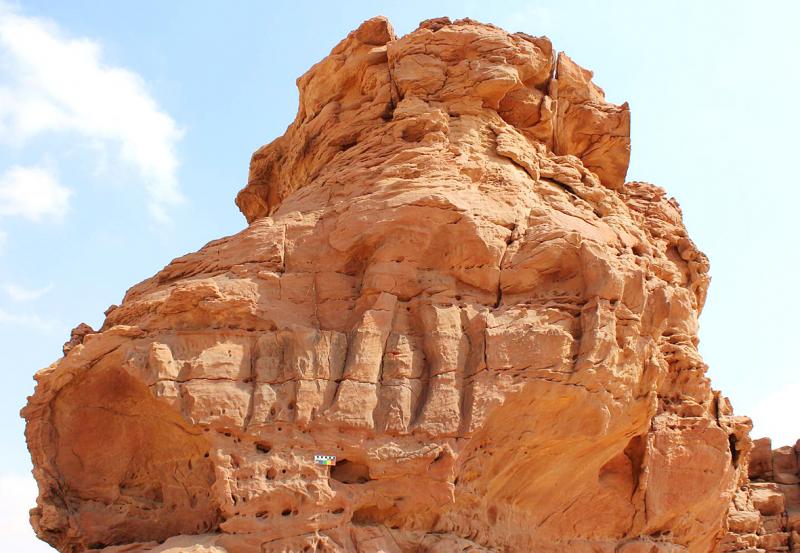Life-sized carvings of camels and horses hewn into rock faces in Saudi Arabia could be around 7,000 years old, according to new research that suggests they are significantly older than previously thought.
The 21 reliefs, which were only recently discovered, are heavily eroded and were initially estimated in 2018 to be some 2,000 years old based on similarities with artworks found in Petra in Jordan.
But the new research by Saudi and European institutions used a variety of different methods, including analysing tool marks and erosion patterns as well as x-ray technology, and suggests the reliefs are around 7,000 to 8,000 years old.

Photo: AFP
This would mean that the area of carvings, known as the Camel Site, “is likely home to the oldest surviving large-scale (naturalistic) animal reliefs in the world,” the study said.
In the era that it was created, the region would have looked very different to the arid landscape of today, with a savannah-like grassland dotted with lakes and trees, where wild camels roamed and were hunted.
“We can now link the Camel Site to a period in prehistory when the pastoral populations of northern Arabia created rock art and built large stone structures called mustatil,” the authors said in a press release issued by the Max Planck Institute for the Science of Human History. “The Camel Site is therefore part of a wider pattern of activity where groups frequently came together to establish and mark symbolic places.”

Photo: AFP
‘ANNUAL GATHERING’
The research, published in the Journal of Archaeological Science on Wednesday, was carried out by the Saudi Ministry of Culture, the Max Planck Institute for the Science of Human History, France’s CNRS research institutes and the King Saud University.
The team included a stone mason, who estimated that each relief would have taken up to 15 days of carving to complete.
The authors, who said the reliefs are part of a wider culture of rock art in the region depicting life-sized animals, suggest the works could have been a communal effort that could have been part of an annual gathering of a Neolithic group.
They said references to the mating season in the sculptures could mean they were symbolically linked to the annual cycles of wet and dry seasons.
Given the extensive erosion of the carvings, the researchers said efforts to secure the site were urgent.
“Time is running out on the preservation of the Camel Site and on the potential identification of other relief sites as damage will increase and more reliefs will be lost to erosion with each passing year,” said lead author Maria Guagnin, of the Max Planck Institute.

In the next few months tough decisions will need to be made by the Taiwan People’s Party (TPP) and their pan-blue allies in the Chinese Nationalist Party (KMT). It will reveal just how real their alliance is with actual power at stake. Party founder Ko Wen-je (柯文哲) faced these tough questions, which we explored in part one of this series, “Ko Wen-je, the KMT’s prickly ally,” (Aug. 16, page 12). Ko was open to cooperation, but on his terms. He openly fretted about being “swallowed up” by the KMT, and was keenly aware of the experience of the People’s First Party

Not long into Mistress Dispeller, a quietly jaw-dropping new documentary from director Elizabeth Lo, the film’s eponymous character lays out her thesis for ridding marriages of troublesome extra lovers. “When someone becomes a mistress,” she says, “it’s because they feel they don’t deserve complete love. She’s the one who needs our help the most.” Wang Zhenxi, a mistress dispeller based in north-central China’s Henan province, is one of a growing number of self-styled professionals who earn a living by intervening in people’s marriages — to “dispel” them of intruders. “I was looking for a love story set in China,” says Lo,

It was on his honeymoon in Kuala Lumpur, looking out of his hotel window at the silvery points of the world’s tallest twin skyscrapers, that Frank decided it was time to become taller. He had recently confessed to his new wife how much his height had bothered him since he was a teenager. As a man dedicated to self-improvement, Frank wanted to take action. He picked up the phone, called a clinic in Turkey that specializes in leg lengthening surgery — and made a booking. “I had a lot of second thoughts — at the end of the day, someone’s going

Aug. 25 to Aug. 31 Although Mr. Lin (林) had been married to his Japanese wife for a decade, their union was never legally recognized — and even their daughter was officially deemed illegitimate. During the first half of Japanese rule in Taiwan, only marriages between Japanese men and Taiwanese women were valid, unless the Taiwanese husband formally joined a Japanese household. In 1920, Lin took his frustrations directly to the Ministry of Home Affairs: “Since Japan took possession of Taiwan, we have obeyed the government’s directives and committed ourselves to breaking old Qing-era customs. Yet ... our marriages remain unrecognized,